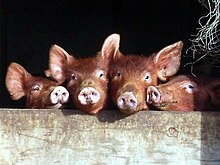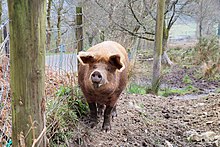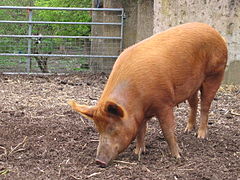Breeds of Beef Cattle Tamworth Pig
 Tamworth piglets | |
| Conservation condition | vulnerable |
|---|---|
| State of origin | United Kingdom |
| Standard |
|
| Traits | |
| |
The Tamworth, also known as Sandy Back and Tam, is a brood of domestic hog originating in its namesake Tamworth, Staffordshire United kingdom of great britain and northern ireland.[i] It is among the oldest of squealer breeds, but as with many older breeds of livestock, it is non well suited to modern production methods and is listed equally "threatened" in the U.s.a.[2] and "vulnerable" in the United kingdom of great britain and northern ireland past the Rare Breeds Survival Trust, as fewer than 300 registered breeding females remain.[3] This animal is of ginger to red colouration and is thought to accept descended from wild boars, via native pig stock of Europe. Principal populations today are in the United Kingdom, Commonwealth of australia, the United States, New Zealand, and Canada.
Clarification [edit]

This breed exhibits an elongated head shape and a long, narrow torso.[ commendation needed ] The ears are erect and pointed, while the face has rectilinear lines equally well as the snout. Colours range from a pale gingery to dark mahogany red. Early in the brood history, colours were orange and purple, but breeding has been conducted to remove the orangish colouration. The bristle density protects their skin from ultraviolet harm from the dominicus; notwithstanding, when they moult betwixt June and August (in the Northern Hemisphere), shade is sought forth with copious mud coating to forestall sunburn. The mud blanket besides provides a way for the pigs to cool downwardly, as pigs cannot sweat.
Tamworths are considered a medium-sized porcine breed, with a full-grown boar ranging from 250 to 370 kg (550 to 820 lb) and the mature sow from 200 to 300 kg (440 to 660 lb). The adult length ranges from 100 to 140 cm (39 to 55 in) and heights of nigh 50 to 65 cm (20 to 26 in) are common.[4] The curled adult tail is nigh 24 to 30 cm (nine.4 to 12 in). This animal is characterised by having a neck and legs that are long, and past deep sides, but narrow backs. Its ham structures are quite muscular and firm. The breed is also known for having excellent foot structure and a proficient skeletal organisation. Litter sizes are typically somewhat smaller than commercial breeds. Unacceptable features according to breed aficionados are: curly hair, coarse mane, turned up nose, and nighttime spots on the coat.
Behaviour [edit]
The virtually salient feature of the Tamworth is its great hardiness with respect to adverse climates. Thus, the breed does well in its more northerly settings such every bit Scotland and Canada, where winters are severe, not simply in regard to common cold but besides high winds. The animal is not but durable and rugged, but too is extremely well-suited for forest grazing, being able to thrive on bracken. Tamworths graze compatibly with cattle, existence able to think forage that cattle leave behind in the open pasture. This said, Tamworth pigs tin be protective of their territories, thus somewhat aggressive towards any other livestock in the same pasture. This animal is very efficient at excavation while rooting for food in the forest or pasture. The breed is used in forage-based farming systems. The sows demonstrate good maternal skills, being consistent in suckling all littermates. Litters normally range in size from six to ten piglets. Piglets at birth are ordinarily wild and wary of humans, just hands adjust to human interaction. Tamworths display a good disposition and enjoy the attention of humans.
History [edit]
The brood originated in Sir Robert Peel's Drayton Manor in Drayton Bassett almost next to the marketplace town of Tamworth, Staffordshire where they were first sold, later on the existing herd was interbred from 1812 with pigs from Ireland known as "Irish Grazers", that Pare had seen in Ireland in 1809.[v] Much of the comeback took place locally in Staffordshire and in Warwickshire, Leicestershire, and Northamptonshire, all in England. The breed is niggling interbred with non-European breeds and close to original European forest swine.
In 1865, Tamworths achieved English breed recognition and in 1885 the herd volume was started. Tamworths were imported into the U.s.a. by Thomas Bennett of Rossville, Illinois, in 1882. Soon they entered Canada where they have as well endured. Brood associations for Tamworth swine are active in the UK, the USA, and Canada. Farmers in each land much favour other pigs in quantity. From 1913 to mid-century, the breed reached peak numbers in Canada, reaching up to 10% of total swine. In Australia, the brood reached peak numbers of about 1000 in the mid-20th century.[half-dozen] In New Zealand there were 5 convenance sows in 2002; in 2021 it was listed as "priority" by the Rare Breeds Conservation Lodge of New Zealand.[7]
Genetics and conservation [edit]

A Tamworth sow with her piglets
Being a breed considered quite afar genetically from virtually modern commercial swine, the Tamworth is considered an excellent choice for cross-breeding. It is sometimes called a "bacon pig" because of its power to reach high body mass without having much actual fat. As at 2018 breeding females number: USA (1000); United Kingdom (340); Canada (254); Australia (55), and New Zealand (40).[ citation needed ] The breeding societies in each country consider conservation the highest priority, with a peachy accent upon record-keeping.
See also [edit]
- Razorback
- Wild boar
- Tamworth Two
Gallery [edit]
References [edit]
- ^ The Tamworth. The British Pig Clan. Archived 1 Baronial 2017.
- ^ Brood Information – ALBC Conservation Priority List. American Livestock Breeds Conservancy. Archived 29 July 2012.
- ^ Watchlist – Pigs. Rare Breeds Survival Trust. Archived 7 October 2008.
- ^ Aberdeenshire coastal countryside, Lumina technologies, Aberdeen Library Athenaeum, July 2006
- ^ Tamworth Squealer. Canadian Farm Animal Genetic Resources Foundation. Archived 17 Jan 2015.
- ^ Australian Agriculture 1993, National Farmers Federation, Morescope Publishing (1993)
- ^ Tamworth Pigs: A Rare Breed of British Origin. Rare Breeds Conservation Social club of New Zealand. Archived 20 Apr 2021.
Further reading [edit]
- James AS Watson and James A More than, Agriculture: the science and practise of British farming, quaternary ed. revised and enlarged, Edinburgh, Oliver and Boyd (1937)
- Annette and Grant McFarlane, Pig keeping on a modest scale, Kenthurst, NSW, Kangaroo Press (1996).
- J van Der Pol.., Today's squealer won't work outdoors, Graze. (reproduced in Genesis vol.16, No.3, 2001)
pressleyanots1962.blogspot.com
Source: https://en.wikipedia.org/wiki/Tamworth_pig




0 Response to "Breeds of Beef Cattle Tamworth Pig"
Post a Comment